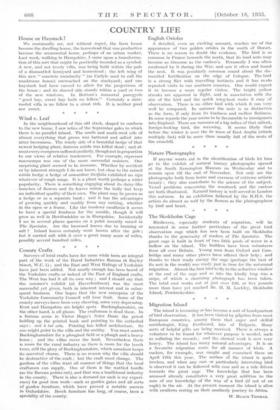County Crafts.
Surveys of local crafts have for some while been an integral part of the work of the Rural Industries Bureau (6 Bayley Street, W.C. 1) ; and the East and West Ridings of Yorkshire have just been added. Not nearly enough has been heard of the Yorkshire crafts or indeed of the East of England crafts. The West has had it all its own way ; and I should say that the summer's exhibit (at Haverfordwcst) was the most successful yet given, both in inherent interest and in subse- quent business. One hopes that the new enterprise of the Yorkshire Community Council will bear fruit. Some of the county surveys have been very cheering, some very depressing. Kent and Hampshire are bright spots. Buckinghamshire, on the other hand, is all gloom. The craftsman is dead there. In a famous scene in Victor Hugo's Notre Danie the priest holding up the printed book and pointing to the cathedral says : ceci a tue cela. Printing has killed architecture. So one might point to the villa and the smithy.. You must search Buckinghamshire for a ploughed field or a plough and a heavy horse ; and the villas cover the land. Nevertheless there is room for the rural industry as there is room for the beech trees, still the glory of Buckinghamshire, which somehow keeps its ancestral charm. There is no reason why the villa should be destructive of the craft ; but the craft must change. The gardens of the villas want all manner of things that the local craftsmen can supply. One of them is the wattled hurdle (as the Bureau points out), and that was a traditional industry in the county. There is also a demand (or such is my experi- ence) for good iron work—melt as garden gates and all sorts of garden furniture, wkich have proved a notable success in Oxfordshire. Beech furniture has long, of course, been a speciality of the county.


























































 Previous page
Previous page